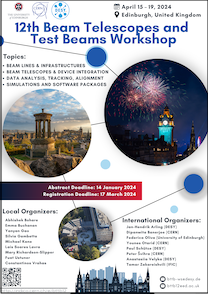Speaker
Description
One of the DESY Tangerine Project is to evaluate monolithic active pixel sensors (MAPS) that are produced with small collection electrodes and in a 65 nm CMOS imaging technology. Consequently, precise simulations have proven essential for characterizing and predicting sensor performance, leading to improved performance designs.
To accomplish this kind of characterization, a simulation strategy can combine Monte Carlo simulation with electrostatic field simulations using Technology Computer-Aided Design (TCAD). The conventional square/rectangular pixel arrangements offer convenient fabrication and readout electronics, along with well-established data processing and analysis methods. However, there is a growing interest in the use of hexagonal pixel detectors as some different prototypes have been developed. The presented study investigates a hexagonal pixel grid arrangement to demonstrate potential benefits over square or rectangular pixel layouts.
Efficiency, cluster size, and spatial resolution are used to evaluate these different configurations, and the square and hexagonal pixel geometries are compared. Transient simulations in detectors are also executed to model the time-dependent behavior of detectors in response to incident particles of hexagonal pixels. The investigations undertaken in this work underscore the potential of the hexagonal pixel grid to enhance the performance of MAPS in high-energy physics experiments.
